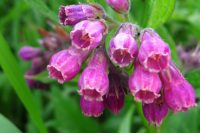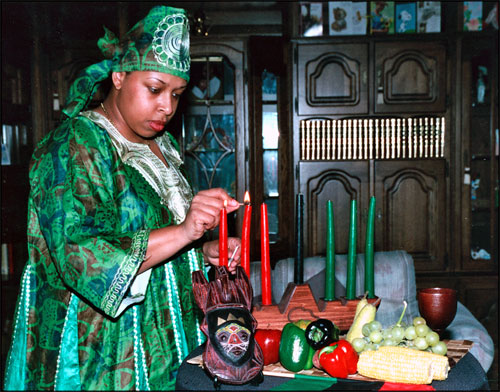Many of us have heard of the African-American celebration called Kwanzaa, but I must confess that I along with the majority have not known what it actually is.
Reading a recent article published in the Los Angeles Daily News, I was happy to learn that this may be one seasonal celebration that I could completely embrace if for no other reason than the fact that it is not yet weighed down with the rank commercialism that all but overshadows the true meaning of Christmas — which, to the best of my universalist religious thinking, is the celebration of the birth of a “God of Love.” Indeed, when we pull aside the greed-thickened “tinsel-ly” veil where the presents we receive or did not receive obscures any deeper meaning to the holiday, many of us become disheartened as we see our friends and family overrun with greed mania in their inevitably unfulfilled search for ultimate self-satisfaction.
I come to the writing of this entry as Christmas day in my home and family has wound down, and at this late hour I may not have the opportunity to prepare for a full-on Kwanzaa celebration. I hope that next year I will be better prepared, with a specially set aside table or altar, with the kinara or seven candles, three green and three red with one central black candle in honor of the Black race. Those who may have difficulty singling out a particular ethnic race can look at it as a symbol of the geographical origin of the human race, which according to archeological consensus, seems to be on the African continent. One might also consider the extent to which black people — long the minority in Europe and North America and who continue to rise to prominence in artistic, athletic, intellectual, social and certainly political spheres, with the election of the first black African-American (or mixed blood) person to the American presidency — have in the past embraced “white”-oriented holidays and celebrations.
The seven-day celebration of Kwanzaa conveniently begins on December 26, the day after Christmas, providing a second chance for us to “get it right” through following, in our own way, what it means in the highest sense to be human through the specific observances of each day. One meditates each day on the meaning of a different theme and discusses it with family and friends. Hopefully these observances prepare us to usher in a new year of positive resolve on our wonderful mother, planet Earth, and to give back the fruits of our minds and physical labors for the betterment of all. (Check out this website for a more comprehensive discussion on the meaning and observance of Kwanzaa.)
The daily observances of the seven days of Kwanzaa are as follows:
Day 1 – Unity
Day 2 – Self-determination
Day 3 – Collective work
Day 4 – Responsibility
Day 5 – Cooperative economics
Day 6 – Purpose
Day 7 – Creativity and faith
As part of my Kwanzaa celebration this year, I would like to share with you a poem and herb each day on the above themes.
Unity: “I Have Learned So Much” by Hafiz
Today, December 26, is the first day of Kwanzaa and the reflection is on Unity.
Here is a poem on the theme of unity by the 14th-century Sufi Persian mystic and poet Hafiz, as translated and interpreted by Daniel Ladinsky:
I Have Learned So Much
I
Have
Learned
So much from God
That I can no longer
Call
Myself
A Christian, a Hindu, a Muslim,
A Buddhist, a Jew.
The Truth has shared so much of Itself
With me
That I can no longer call myself
A man, a woman, an angel,
Or even pure
Soul.
Befriended Hafiz so completely
It has turned to ash
And freed
Me
Of every concept and image
My mind has ever known.
 As an herbalist, I believe that herbs possess spiritual powers. Of course, all plants and creatures are derived from a single life source and therefore have spiritual energy. How we choose to focus our attention in a particular way on a particular plant such as its growing habit, color, location, form, healing properties and uses, empowers it through our intention with special spiritual powers.
As an herbalist, I believe that herbs possess spiritual powers. Of course, all plants and creatures are derived from a single life source and therefore have spiritual energy. How we choose to focus our attention in a particular way on a particular plant such as its growing habit, color, location, form, healing properties and uses, empowers it through our intention with special spiritual powers.
Comfrey (Symphytum officinalis) has the power power to mend torn flesh, broken bones, sores and ulcers. As a plant, comfrey itself is practically indestructible. Its roots reach deep down many feet into the subsurface of the soil, availing itself of all the rich mineral elements of the earth that in turn allow it to be used to heal and mend. All parts of the plant can be used with the mucilaginous root being the most healing.
In recent years, comfrey has suffered from the revelation that it contains varying but small amounts of pyrrolizidine alkaloids. Other plants which contain these alkaloids can cause a deadly condition called “veno-occlusive disease.” Plants are biochemically complex and contain hundreds of constituents, some of which in isolation are indeed poisonous.
However, out of generations of people who have and continue to take comfrey, my own years of use and promoting its use in seminars to thousands of people, I have yet to find a single case where one can ascribe such an adverse result from it. This doesn’t mean that it isn’t possible; different people can manifest what is called an “idiosyncratic” reaction to just about anything, be it a food, drink or an herb such as comfrey. Comfrey root remains one of the most fantastic herbs for healing fractures and collapsed spinal disks, while at the same time relieving pain associated with these conditions.
To use comfrey, simmer three heaping tablespoons of the dried root or about twice that amount of the fresh, finely chopped root in 3.5 cups of boiling water in a covered pot over a low flame for 20 minutes. Have one cup three times daily for two weeks. Then take a break for a week or so before repeating. At the same time you can get obtain the positive results from comfrey by applying a warm external fomentation of the tea directly over the affected area. For a back injury, one can take a flannel shirt and moisten the part of the shirt that is in contact with the affected area of the body and wear it to bed each night with a plastic covering to protect the bedding. For a wrist, elbow or knee injury, simply moisten a similar cloth, lightly ring it out and apply directly over the affected joint covering with plastic and leaving it on through the night. This external use of comfrey is completely safe to do over a long period of weeks or months as needed.
Sprinkling a little cayenne powder on the cloth will further activate the properties of comfrey.
So as we meditate on the theme of unity, consider how the power of an herb such as comfrey can heal and unify broken and disparate aspects of our body and mind into a stronger and new unity with ourselves and the world.

